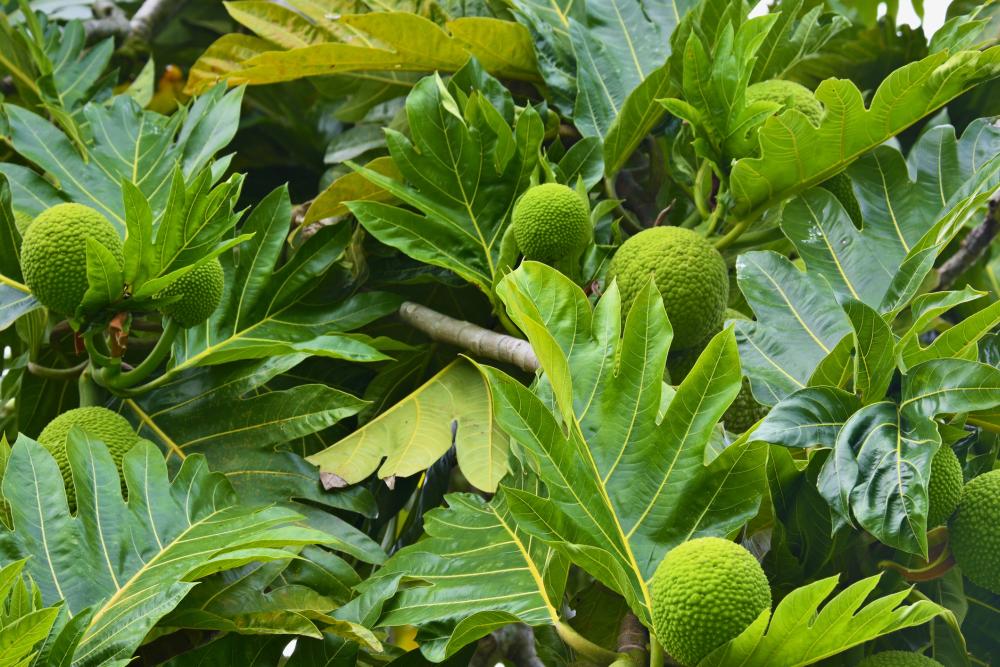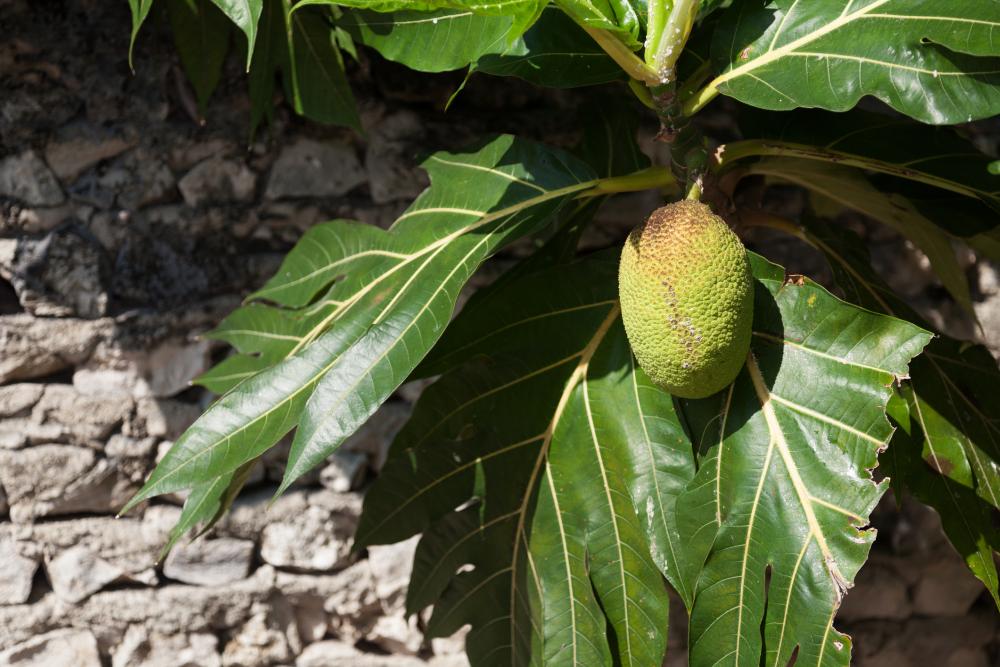6 Breadfruit Growing Problems And How To Solve Them
Although breadfruit grows on a sturdy tree, it’s not immune to many breadfruit growing problems. It’s hard to imagine a large tree succumbing to a fungal infection or some viral disease. But you need to check on your tree regularly and detect the signs early.
Some of the breadfruit growing problems have to do with poor care since the tree needs winter protection in cool zones. Pruning the tree can also make or break the harvest the next year, so you’ll need to pay extra attention to that. But other problems are just acts of nature such as when the fruits fall off the tree before they’re ripe. The tree might also get a bug infestation or a fungal infection.
All these problems and more are discussed below. Read more to find out how to deal with such issues and how to keep the breadfruit healthy year after year.
Breadfruits Falling Off Tree
Even though breadfruit trees have some stunning canopies and the glossy leaves are quite ornamental, the main reason people grow them is the fruits. The highly nutritious fruits are a good substitute for wheat flour not to mention that they’re also gluten-free.
So you would be more than worried when the precious fruits start dropping to the ground even though they’re obviously not ripe yet. And while it’s normal for a tree laden with more fruits than it can handle to get rid of some of the extra weight, sometimes it’s a sign that things are not well with the tree. The causes range from poor pollination to drought and even stress. So what can you do about the breadfruits falling off the tree?
How to Fix It
When the fruits are still in development start to drop on the ground, you need to make sure it’s not the tree having an overbearing problem. In that case, the tree will drop a few fruits at a time and after about a week, you won’t see any more fruits under the tree. But if you keep seeing more fruits falling off the tree and they seem to be getting more and more as the days go by, check for the other causes of the problem.
- Poor Pollination: Pollinators play a major role in the size of the harvest you get every year. If they don’t do their job, the harvest will drop drastically. The reason the pollinators don’t visit the tree might be the rainfall season coinciding with the blooming season of the breadfruit tree. Cross-pollination is also important, so you’ll need to have another breadfruit tree within a 50 feet radius to improve pollination.
- Drought: Not all fruit trees are hardy to dry soil. And the breadfruit tree is rather sensitive to the absence of moisture in the soil. The tree would go into self-preservation mode and drop off the fruits which take up a lot of resources. So water the tree regularly during the growing season and don’t allow more than 2 inches of the top soil to go dry at a time.
- Stress: Besides drought, too much weight on the branches can cause stress for the tree. Some breadfruit varieties weigh up to 6 pounds. When the branches bend down under the weight of the fruits, the tree resorts to dropping some of them to avoid breaking the branches. You can deadhead the blossoms to avoid this problem and allow enough space between the fruits to distribute the weight across the length of the branch.
Breadfruit Winter Protection
Since breadfruit trees are native to the tropical regions and are used to high temperatures and steep humidity levels, you might have a problem with your cold winters and frost. This is especially true if you live in zones below 10 or have an especially unpredictable microclimate with overly harsh winters.
In general, breadfruit trees grow well in Florida and Hawaii with few weather-related problems. These trees are known to be hardy to temperatures as low as 30 degrees F. However, it’s not a good idea to subject your tree to any temperature below 60 degrees F. It can seriously impact the crop and the tree might even stop growing for a while. So how would you protect the breadfruit tree against the cold winter months?
How to Fix It
Admittedly it’s not easy to provide winter protection to a tree that grows to 80 feet tall. You can hardly plant it in a container and move it indoors. That said, there are varieties that are more compact and container-friendly. Those trees will grow well in a large pot and are easy to move around and keep indoors until the cold months are over.
If the winter temperature in your zone doesn’t drop below 55 degrees F during the daytime for weeks on end, then you won’t have to winterize the tree. Just cover the ground under the tree with a thick layer of mulch to preserve the soil temperature. You would also need to prune the tree well before the winter to preserve its energy. The following two sections deal with those two issues in more detail.
Potted Breadfruit Trees
If the breadfruit averages anything from 2 to 6 pounds apiece, how big is the tree that produces such a fruit? A lot. On a good day, the average breadfruit tree can tower over 80 feet. So how would you grow such a giant in a pot? The simple answer is you don’t. You just find a more compact variety and plant it in a container.
Now there are a few caveats to growing a potted breadfruit tree. The first is that you won’t get as many fruits as a tree growing in the garden. The second is that you can only grow small varieties and cultivars. And even then, you’ll need to prune them regularly to keep the canopy manageable.
How to Fix It
While growing the potted breadfruit tree might not be very different from planting the tree or its seed in the garden, caring is a different ball game. Let’s start with the basics and move on to more advanced care tasks.
- The container that will hold the tree needs to be of equal size and sturdiness. Choose a container that’s at least 20 inches high with a matching diameter.
- Plastic containers do better than terra cotta ones because they retain moisture better.
- Keep the soil in the pot moist regularly but not overly wet.
- Take the container out during the spring and summer and allow the tree to get at least 8 hours of sunlight per day.
- When the temperature drops below 60 degrees F. you need to bring the containers back indoors and keep them until the winter months are over.
- During the winter, keep the container near a window facing the south or west to get plenty of sun every day.
Breadfruit Pruning Guide
Pruning for fruit trees is more than just a way to keep them looking their best and avoid any wayward branches from ruining the appearance of the tree. Pruning has a more practical purpose of encouraging more robust lateral growth and increasing the annual yield. This is true for many fruit trees as it is true of breadfruit trees.
But pruning breadfruit trees is a little different since you’ll need to allow the young tree enough time to establish its roots and develop the main branch structure. Only then would you take your pruning shears to it. Also, the timing of the pruning is a little different from other trees and varies depending on the cultivar and time of harvest. Some breadfruit varieties keep producing fruits all year round while others have the main harvest and another smaller one a few months later.
How to Fix It
When pruning the breadfruit tree, you should wait for the main harvest to be over before you trim off the top branches and shoot. If you have a variety that produces two harvests, then wait for the second harvest before you prune the tree. Either way, pruning should be done before the tree produces its vigorous annual growth.
Allow the young tree to grow freely for the first two or three years of its life before you start pruning it. However, if you’re growing a potted breadfruit tree, then pruning should be an annual task as soon as the main branches develop.
Always wear protective gear and wear shoes not sandals when pruning the tree. And if the tree is too large, consider hiring a professional.
Bugs That Eat Breadfruit
Just as we find the fruits of the breadfruit tree delicious, so do bugs. And while some pests will only feed on the leaves, they can still cause a lot of damage to the canopy and hence the crop. The problem with trees of this size is that you can’t possibly detect insects crawling all over the branches and leaves. Nor see the holes in the leaves until they’re big enough to be seen 40 feet away. So by the time you realize your breadfruit tree has a bug infestation, it would usually be too late to save the crop that year. So what are the common breadfruit tree bugs and how can you protect the harvest against them?
How to Fix It
While many bugs in the garden can find the leaves of the breadfruit tree attractive, the two main pests to watch out for are mealybugs and soft scale. Here’s how to deal with those two along with the other pests that attack the tree.
- Mealybugs: They are easy to detect since they leave behind a white substance that looks like cotton. They feed on the sap of the trees and in large numbers could damage the tree’s canopy. Spray the tree with neem oil to get rid of them.
- Soft Scale: This insect leaves behind a thick substance that triggers fungal infections. So their devastation of the tree is double-fold. Treat them with insecticides and neem oil spray.
- Leafhoppers: They are larger in size than the above two insects and can be detected with the naked eye.
- Slugs and Snails: They crawl up the trunk of the tree and live among the branches. They’re voracious insects and can cause serious damage to the leaves in a short time. Call a specialist in the case of large infestations of any of the above insects.
Brown Breadfruit Leaves
The leaves of the breadfruit tree are glossy and dark green. They’re part of the tree’s charm and add a lot of ornamental value to the breadfruit tree. But sometimes the leaves will turn yellow or even brown and fall before their time. For an evergreen tree, that’s an alarming sign.
It’s often an indication that the tree is infected with soft rot. A bacterial disease that spreads in high humidity after rainfall and with poor ventilation.
How to Fix It
Regular pruning of the breadfruit tree can prevent soft rot infections. Not just because pruning improves ventilation but also because the fungus infects the lower branches of the tree. By removing those branches, you can prevent the disease from spreading.
Trim off infected branches immediately and dispose of them by burning them. And as a precaution, don’t overwater the soil and improve air circulation around the tree during the spring and summer months.



